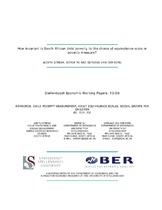| dc.contributor.author | Yu, Derek | |
| dc.contributor.author | Streak, Judith | |
| dc.date.accessioned | 2021-03-08T07:50:15Z | |
| dc.date.available | 2021-03-08T07:50:15Z | |
| dc.date.issued | 2008 | |
| dc.identifier.citation | Judith Streak & Derek Yu & Servaas van der Berg, 2008. "How invariant is South African child poverty to the choice of equivalence scale or poverty measure?," Working Papers 13/2008, Stellenbosch University, Department of Economics | en_US |
| dc.identifier.uri | https://www.ekon.sun.ac.za/wpapers/2008/wp132008/wp-13-2008.pdf | |
| dc.identifier.uri | http://hdl.handle.net/10566/5969 | |
| dc.description.abstract | This paper offers evidence on the sensitivity of child poverty in South Africa to changes in the Adult
Equivalence Scale (AES) and updates the child poverty profile based on the Income and Expenditure
Survey 2005/06. Setting the poverty line at the 40th percentile of households calculated with different
AESs the scope and composition of child poverty are found to be relatively insensitive to the scale used.
The rankings of children of different ages, girls versus boys, racial groupings and children living in rural
versus urban areas are unaffected by choice of AES, although some provincial rankings on the poverty
headcount measure are. The proportions of children and households ‘correctly’ identified as poor for the
full range of scales is extremely high. These findings support the argument of Woolard & Leibbrandt
(2006) that it may be appropriate for profiling poverty in South Africa to use a poverty line based on a
per capita welfare measure. For the construction of the child poverty profile, per capita income is used
as the welfare indicator with the poverty line set at the 40th
1 *Child Youth Family and Social Development, Human Sciences Research Council, South Africa;
**Department of Economics, Stellenbosch University South Africa.
percentile of household. The profile suggests
that poverty amongst children is more extensive than amongst the population or adults even after the
massive injection of transfers into households with poor children through the child support grant. The
child poverty headcount, depth and severity are all highest amongst children age 0-4 and lowest
amongst those aged 15-17, who are not yet beneficiaries of the grants. They are also highest amongst
African and Coloured children. Large variations across provinces remain. | en_US |
| dc.language.iso | en | en_US |
| dc.publisher | Stellenbosch University | en_US |
| dc.subject | Child poverty measurement | en_US |
| dc.subject | Adult equivalence scales | en_US |
| dc.subject | Social grants for children | en_US |
| dc.subject | South African | en_US |
| dc.subject | Children | en_US |
| dc.title | How invariant is South African child poverty to the choice of equivalence scale or poverty measure? | en_US |
| dc.type | Working Paper | en_US |

